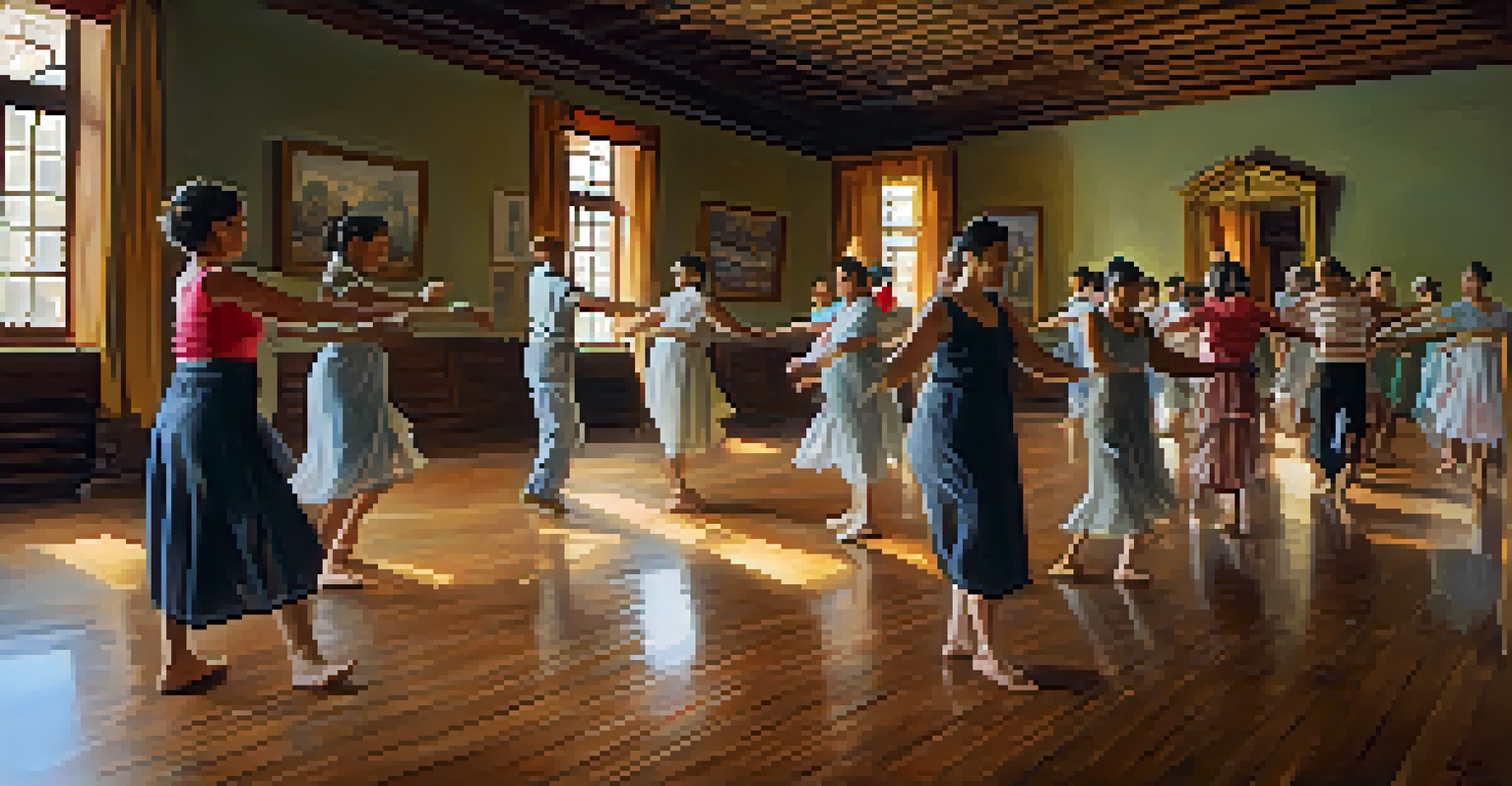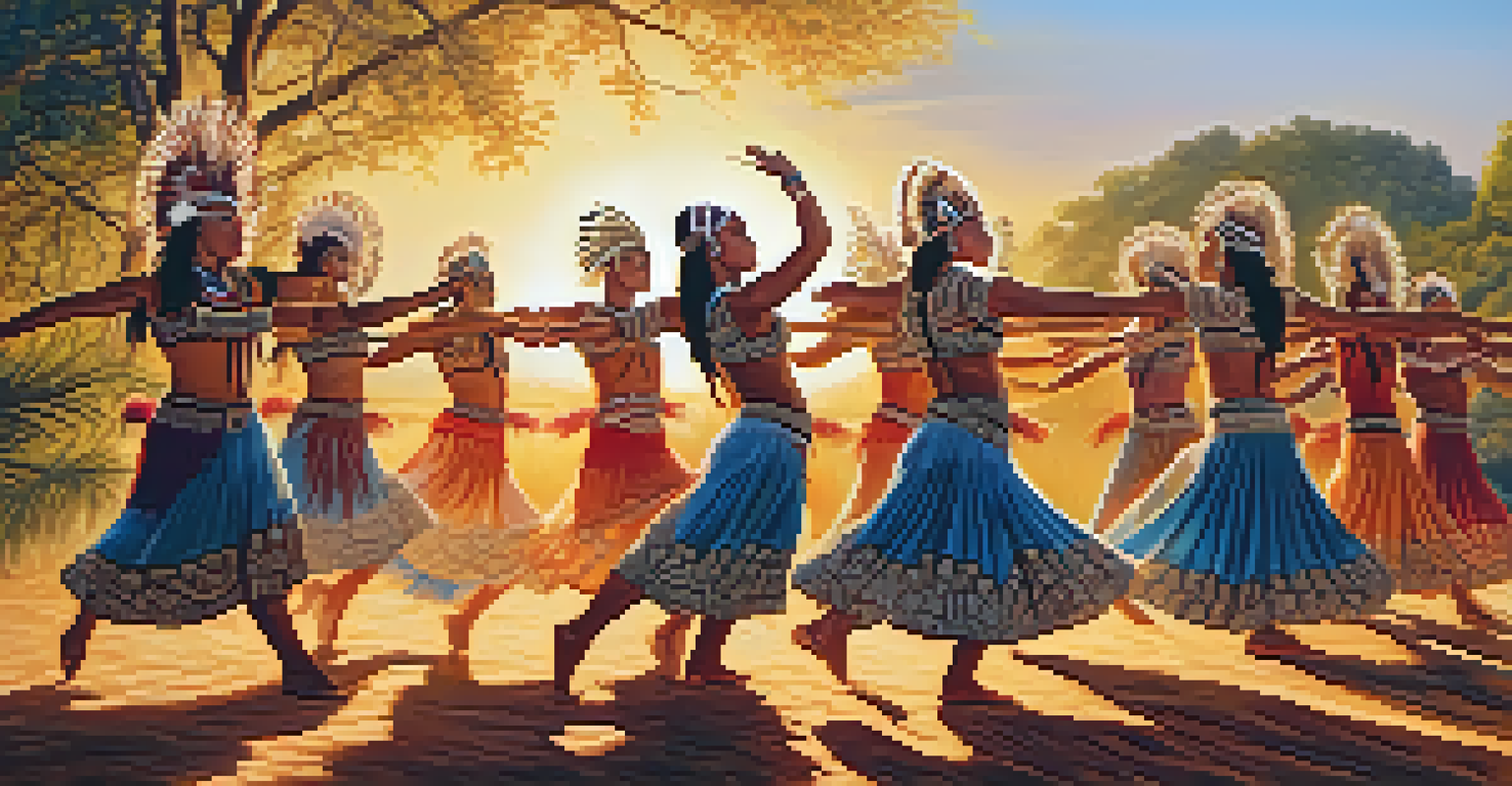Dance as a Medium for Cultural Exchange in Tourism

The Role of Dance in Cultural Identity
Dance serves as a powerful expression of cultural identity, reflecting the values, beliefs, and traditions of a community. Each dance style, from the tango of Argentina to the hula of Hawaii, tells a story that is deeply rooted in its cultural context. This connection between dance and identity makes it a vital medium for showcasing local heritage to tourists.
Dance is the hidden language of the soul.
When travelers engage with local dance forms, they gain insights into the history and customs of the culture they are visiting. For instance, participating in a traditional dance class allows tourists to connect with locals in a meaningful way, fostering a sense of shared experience. This interaction not only enriches the travel experience but also promotes cultural appreciation and understanding.
Moreover, by highlighting their unique dance traditions, communities can attract tourists who are eager to learn and participate. This creates a dynamic exchange, where dance becomes a bridge linking diverse cultures, ultimately enhancing the tourism experience for both visitors and hosts.
Dance Festivals: Celebrating Diversity Through Movement
Dance festivals are vibrant events that bring together various cultures, showcasing their unique dance forms on a shared platform. These festivals invite participation from locals and tourists alike, creating a festive atmosphere that celebrates diversity. For example, the International Festival of Dance in Paris attracts performers and audiences from all over the globe, enriching the cultural landscape of the city.

During these events, attendees can enjoy performances that highlight different dance styles, from traditional folk dances to contemporary interpretations. This exposure not only entertains but also educates audiences about the cultural significance behind each performance. Participants often leave with a deeper appreciation for the artistry and history of each dance form.
Dance Reflects Cultural Identity
Dance serves as a vital medium for showcasing local heritage and fostering cultural appreciation among tourists.
Additionally, dance festivals stimulate local economies by drawing in tourists who contribute to businesses such as hotels, restaurants, and shops. As festival-goers immerse themselves in the local culture, they also create lasting memories and connections that promote repeat visits and word-of-mouth recommendations.
Workshops: Learning Dance as a Cultural Exchange
Dance workshops provide an interactive opportunity for tourists to learn about a culture through its dance. These hands-on experiences allow travelers to engage directly with local dancers and instructors, deepening their understanding of the movement's cultural significance. For instance, a Flamenco workshop in Spain not only teaches steps but also shares the history and passion behind the dance.
The dance is a poem of which each movement is a word.
By participating in such workshops, tourists often find themselves immersed in the culture, as they learn not just the movements but also the stories and emotions that accompany them. This interaction fosters a sense of connection, bridging the gap between cultures in a way that is both enjoyable and educational. It’s a unique way for travelers to take home a piece of the culture they’ve experienced.
Furthermore, workshops can serve as a platform for cultural exchange, where locals and tourists share their experiences and perspectives. This reciprocal learning enriches both parties, as tourists gain new skills while locals enjoy the opportunity to showcase their heritage in a welcoming environment.
Dance as a Tool for Social Change in Tourism
Dance can also act as a catalyst for social change, highlighting issues within communities while attracting tourists. Many dance groups use their performances to raise awareness about social justice, environmental concerns, or cultural preservation. For instance, Indigenous dance troupes might showcase their traditions to emphasize the importance of land rights and cultural survival.
By incorporating messages into their performances, these dancers invite tourists to reflect on the broader implications of their visit. This not only enhances the travel experience but also encourages a more responsible approach to tourism, where visitors become advocates for the causes they encounter. Such awareness can lead to meaningful support for local initiatives.
Workshops Foster Cultural Exchange
Dance workshops provide tourists with hands-on experiences that deepen their understanding of cultural significance.
Moreover, when tourists engage with dance that focuses on social issues, they contribute to a narrative that values authenticity and respect for local cultures. This approach fosters a more sustainable tourism model, where visitors leave with a greater understanding of the complexities within the cultures they explore.
The Influence of Technology on Dance Tourism
The rise of technology has transformed the way dance is shared and experienced in tourism. Social media platforms like Instagram and TikTok allow dancers to showcase their talents to a global audience, sparking interest and curiosity about different cultures. This visibility can lead to an increase in tourism, as people are inspired to travel to experience the dances they’ve seen online.
Virtual dance classes and performances have also made cultural exchange accessible to a wider audience. Tourists can engage with local dance forms from the comfort of their homes before deciding to visit, creating a sense of anticipation and connection. This digital interaction often serves as a precursor to in-person experiences, enhancing the overall journey.
However, while technology opens doors, it’s essential to balance it with authentic experiences. Tourists should seek opportunities to connect with local communities and participate in traditional practices, ensuring that their engagement goes beyond what can be captured on a screen.
Dance as a Means of Preserving Cultural Heritage
Dance plays a crucial role in preserving cultural heritage, serving as a living archive of traditions and stories passed down through generations. Many cultures rely on dance to keep their history alive, using it as a means of education for younger generations. This continuity ensures that the unique aspects of a culture remain vibrant and relevant, even in a rapidly changing world.
Tourism can significantly contribute to this preservation effort, as interest from visitors can motivate communities to sustain their dance traditions. Festivals, performances, and workshops attract attention and funding, allowing local artists to continue practicing and teaching their craft. This not only benefits the artists but also enriches the cultural landscape for tourists.
Dance Promotes Social Awareness
Dance acts as a catalyst for social change, inviting tourists to reflect on important issues while enjoying cultural performances.
By engaging with dance in their travels, tourists become part of this preservation narrative. They help to validate the importance of these traditions, encouraging communities to maintain their unique identities in the face of globalization and modernization.
The Future of Dance in Cultural Tourism
As the world becomes more interconnected, the role of dance in cultural tourism will continue to evolve. Trends indicate a growing appreciation for authentic and immersive experiences, where tourists seek meaningful connections with local cultures. Dance, with its universal language of movement, is poised to play a significant role in this shift, offering experiences that resonate on a deeper level.
Innovative collaborations between artists and tourism boards can create exciting new opportunities for cultural exchange. For instance, curating dance experiences that combine traditional forms with contemporary influences can attract a diverse audience, appealing to both locals and travelers. This not only revitalizes interest in local dance forms but also fosters creativity and dialogue across cultures.

Ultimately, the future of dance in tourism lies in its ability to adapt and resonate with changing audiences. By embracing innovation while staying rooted in tradition, communities can ensure that their dance forms continue to thrive, enriching the tourism experience for generations to come.